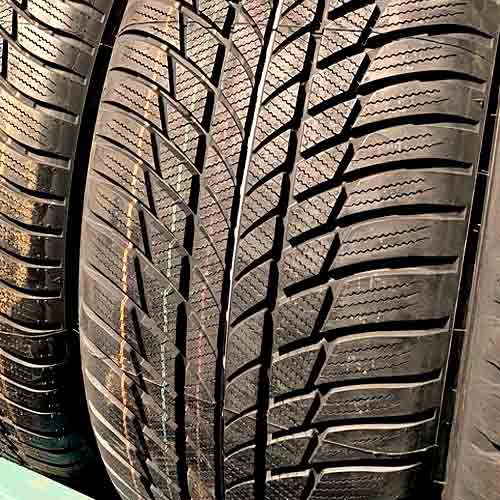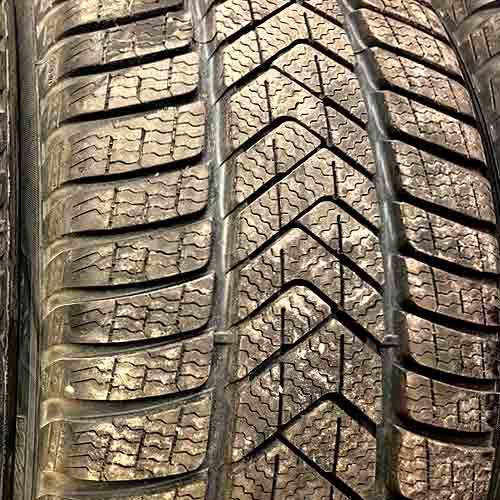Both Pirelli Winter Sottozero 3 and Bridgestone Blizzak LM005 are pretty great overall, comparing other winter tires, I mean. Though its still best to consider following performance sections to find a better fit for you still. Let’s start with tire sizes.

Key Takeaway: Blizzak excels in tread life, ice performance, wet traction, and ride comfort, mostly due to its lighter weight and tread design. The Pirelli, on the other hand, stands out in soft snow performance and fuel efficiency, attributed to its aggressive tread and lighter structure. While the Blizzak offers better directional grip on dry terrains, the Pirelli provides swifter handling. Ultimately, the choice between them hinges on individual driving needs and conditions, as both tires bring unique benefits to the table.
Table of Contents
Tire Sizes
The Bridgestone Blizzak LM005 comes in just 18 sizes in 18 to 20 inches rims, with following specs.
- Speed ratings: H and V.
- Load ratings: XL only.
- Tread depth: 8 to 11/32″.
- Weight: 24 to 36 lbs.
On the other side, the Pirelli Winter Sottozero 3 (review) comes in 16 to 21 inches with following specs.
- Speed ratings: H, V and W.
- Load ratings: SL and XL.
- Tread depth: 10/32″ on all.
- Weight: 18 to 32 lbs.
Tread Life
The longevity of a tire’s tread life is determined by a combination of its weight and the design of the tread itself.
In the case of the Bridgestone Blizzak LM005, its longevity trumps others due to its feather-light constitution.
Its reduced mass allows for a gentler touch with the road, reducing the force exerted on the tire’s rubber.
This diminished friction effectively slows down the burning rate of the tread, thereby enhancing its lifespan.

Conversely, the Pirelli Winter Sottozero 3 offers a heavier composition and a design that comprises a higher void ratio.
The increased weight is distributed over a relatively smaller rubber surface area.
As a result, each lug of the tire experiences heightened pressure, rubbing against the road surface with a larger frictional force. This accelerates the rate of wear, as more stressed up lugs bend more and cause greater heat generation.
And as heat is directly proportional to overall tire’s tread life, especially, when it comes to winter ones, you get a shorter overall tread longevity on Pirelli Winter Sottozero 3, in comparison.
(Even though both tires don’t offer any treadwear warranties).
Ice Performance
It is undisputed that the Bridgestone Blizzak LM005 emerges as a leader in terms of performance on icy terrains.
And this impressive performance can be largely ascribed to its intricate tread design. I mean the tire features better multi-directonal biters (with those curved grooves), and has superior siping of interlocking pattern.

These sipes are structured/oriented in a way, so as to give the tire with better braking abilities from the middle, and handling from its shoulders.
On the contrary, the Pirelli Winter Sottozero 3 finds navigating icy conditions slightly more challenging, attributed to its larger tread voids and sparser notches.
The main tread area grapples to maintain a solid grip on compact ice, and although you also get multi-directional siping here as well, they aren’t as efficient for icy tracks, in comparison.
Though the overall difference is low, since the tire is lighter in weight, which allows for better steering and braking, as it generates smaller momentum inertia which is easier to stop, and which offers good enough under/over steering balance.
But yes, overall, the Bridgestone is taking the lead here.
Dry Traction
As the landscape transitions to dry terrains, the Blizzak LM005 emerges as an outstanding performer, exhibiting an exceptional grasp in terms of directional grip and maneuverability, which are the two paramount facets of dry performance.
Let’s talk directional grip first, which is measured with tire’s stopping abilities.
So this grip depends on central tread area, and here although both tires are directional here, the overall lug pattern on Blizzak is more streamlined, comparatively.
On the flip side, the Pirelli Winter Sottozero 3 is slightly lacking here, (less than a feet in braking distance), but still offers better overall handling, still.
And that’s because if offer better steering communication to the driver’s controls.
Basically the tire has a lighter construction, and this leads to less of its lugs bending. And since lug bending wastes time, as they have to reshaped back together, the overall, steering and handling on Pirelli gets to be faster.
That’s why on average, you see a 0.75 seconds faster handling on Sottozero, relatively.
Wet Traction
A tire’s ability to maintain a secure grip under wet conditions is predominantly dictated by its tread design and rubber composition. Here, despite both the Bridgestone Blizzak LM005 and its rival being equipped with abundant siping and soft, thermally adaptive rubbers, the former outperforms.
The reason? Well it offers better water expulsion.
This is done because:
- The tire offers greater weight.
- It’s tread is better voided up longitudinally and laterally.
- And it offers better siping structure.
Now with greater weight the Bridgestone Blizzak LM005 puts more pressure on its lugs, which basically helps in pushing water out more effectively.
And having said that, with its better groove structure, water is pushed out with better efficacy.
Moreover, while most of the water escape through grooves, you still have to deal with the remaining particles. And that’s where sipes come in.
These sipes basically suck up particles, and since they have a better structure here, you get superior overall performance on Blizzak compared to Pirelli.
On the other hand, the Pirelli Winter Sottozero 3 utilizes a different approach with a predominately lateral orientation of sipes, leading to a slightly lacking traction outcome.
And the tire is also not able to excel as much on hydroplaning resistance too, since it demonstrates slightly lacking float speeds.
So overall, Pirelli Winter Sottozero 3 is lacking overall (slightly), compared to Bridgestone.
Soft Snow Performance
Traversing snowy terrains is a challenging feat, but both tires rise to the occasion quite effectively, each with its unique adaptations to different types of snow.
However, the Pirelli Winter Sottozero 3 is still a better preference for this terrain type due to its more aggressive directional tread pattern. This pattern, complemented by lugs featuring expansive structures, is adept at capturing loose, fluffy snow particles.
Moreover tire’s abundant snow vices and interlocking grooves (with thicker slits) also contribute to trapping snow, which improves the tire’s grip, as snow tends to stick better to itself than to rubber.
In contrast, the Bridgestone Blizzak LM005’s design is denser, even though it also features a continuous central rib.
The absence of an interlocking groove structure hinders the tire from gathering as much snow as its competitor, resulting in a slightly compromised performance in snowy conditions.
Thus, for snow performance, the Pirelli Winter Sottozero 3 claims a distinctive advantage.
Ride Comfort
The comfort offered by a tire ride hinges on a harmonious balance of several factors including road noise, vibration absorption, tread pattern, and sidewall design.
Regarding tread noise, the Bridgestone Blizzak LM005 gains a marginal advantage due to its less voided tread design. This design restricts the volume of air that can enter and circulate, subsequently reducing noise generation.
Further enhancing overall comfort is its lighter structure, which allows for better response times, yielding a smoother and more refined ride compared to its competitor.
Conversely, while the Pirelli Winter Sottozero 3 falls short in noise reduction and road smoothness, it does outshine in one aspect with its softer rubber compound.
This compound excels in absorbing road inconsistencies, making a noticeable difference in ride comfort compared to its counterpart.
Fuel Efficiency
A tire’s fuel efficiency is intimately linked with traction and structural weight, both of which influence the tire’s rolling resistance.
That’s why it makes sense, looking at those above mentioned factors, that the Pirelli Winter Sottozero 3 has the upper hand.
The tire not only weighs less, but has less tread depth on average. So it’s lugs don’t bend as much, relatively.
On the other hand, although the Bridgestone Blizzak LM005 has its streamlined, longitudinally aligned ribs, which do help minimizing rolling resistance, its heavier weight causes more stress on its lugs.
This push on the blocks/tread, causes wasted of energy. Meaning, there’s a greater energy expenditure on de/re-formation of the tread and heat.
So as a result, the Blizzak LM005 comes out with lacking overall fuel economy in comparison.
Summing Up
While both tires have distinct strengths, neither completely overshadows the other, reaffirming the importance of understanding your personal needs when selecting a tire.
The Blizzak LM005 outshines in terms of tread life, ice performance, wet traction, and ride comfort, largely due to its lighter structure, effective tread design, and noise reduction. The tire’s superior water expulsion and quieter ride make it a notable choice for those who prioritize these features.
Conversely, the Pirelli Winter Sottozero 3 takes the lead in soft snow performance and fuel efficiency. Its aggressive directional tread pattern and the ability to capture more snow give it a clear advantage on snowy terrains. Furthermore, its lighter weight combined with reduced tread depth means better fuel efficiency by minimizing rolling resistance.
So as you can see both tires offer mixed results.